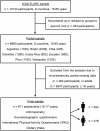Anthropometry, dietary intake, physical activity and sitting time patterns in adolescents aged 15-17 years: an international comparison in eight Latin American countries
- PMID: 31964386
- PMCID: PMC6971876
- DOI: 10.1186/s12887-020-1920-x
Anthropometry, dietary intake, physical activity and sitting time patterns in adolescents aged 15-17 years: an international comparison in eight Latin American countries
Abstract
Background: Although there is high prevalence of obesity and other cardiovascular risk factors among Latin American adolescents, there is limited evidence on dietary intake and physical activity (PA) patterns in this population. Therefore, we characterized anthropometry, dietary intake, PA and sitting time (ST) in adolescents aged 15-17 years from eight Latin American countries.
Methods: Six hundred seventy-one adolescents (41.4% girls) from the Latin American Study of Nutrition and Health (ELANS) were included. Nutritional status was classified by four BMI (kg/m2) categories. Waist circumference (WC) was categorized as above or below thresholds. Dietary intake was assessed through two non-consecutive 24-h dietary recalls. PA and ST were measured using the International Physical Activity Questionnaire (IPAQ). We calculated overall and country-specific estimates by sex and tested for differences between boys and girls.
Results: Differences in the prevalence of overweightness (15.1 and 21.6%) and obesity (8.5 and 6.5%) between boys and girls, respectively, were statistically insignificant (p = 0.059). Average energy intake was 2289.7 kcal/day (95% CI: 2231-2350) for boys and 1904.2 kcal/day (95% CI: 1840-1963) for girls (p < 0.001). In relation to macronutrient intake for boys and girls, respectively, the average intake (expressed as percentage of total energy) was 15.0 and 14.9% for protein; 55.4 and 54.9% for carbohydrates; 14.1 and 14.5% for added sugar; 29.5 and 30.1% for total fat; and 9.6 and 9.9% for saturated fat (p > 0.05 for all outcomes). There was no statistically significant difference in the prevalence of total energy (TE) saturated fat and added sugar (>10% of TE) between girls and boys (49.6% versus 44.8 and 81.7% versus 76.1%, respectively). Prevalence of physical inactivity was 19% in boys and 43.7% in girls (p < 0.001). Median levels of vigorous-intensity PA and total PA were significantly higher for boys than for girls (p < 0.05 for both outcomes); whereas levels of ST were similar (273.7 versus 220.0 min/day for boys and girls, respectively; p > 0.05).
Conclusions: These findings highlight the high prevalence of poor dietary intake and physical inactivity in adolescents from Latin American countries. Therefore, effective and sustainable strategies and programmes are needed that promote healthier diets, regular PA and reduce ST among Latin American adolescents.
Trial registration: Clinical Trials NCT02226627. Retrospectively registered on August 27, 2014.
Keywords: Anthropometry; Energy intake; Macronutrients; Obesity; Physical activity; Sedentary behaviours; Total fat.
Conflict of interest statement
The authors declare that they have no competing interests.
Figures
References
-
- GBD 2015 DALYs and HALE Collaborators Global, regional, and national disability-adjusted life-years (DALYs) for 315 diseases and injuries and healthy life expectancy (HALE), 1990–2015: a systematic analysis for the Global Burden of Disease Study 2015. Lancet. 2016;388:1603–1658. doi: 10.1016/S0140-6736(16)31460-X. - DOI - PMC - PubMed
-
- World Health Organisation . Noncommunicable diseases and mental health. 2014. Global status report on noncommunicable diseases 2014.
-
- Pullar J, Allen L, Townsend N, Williams J, Foster C, Roberts N, et al. The impact of poverty reduction and development interventions on non-communicable diseases and their behavioural risk factors in low and lower-middle income countries: a systematic review. PLoS One. 2018;13:e0193378. doi: 10.1371/journal.pone.0193378. - DOI - PMC - PubMed
-
- NCD Risk Factor Collaboration Worldwide trends in body-mass index, underweight, overweight, and obesity from 1975 to 2016: a pooled analysis of 2416 population-based measurement studies in 128.9 million children, adolescents, and adults. Lancet. 2017;390:2627–2642. doi: 10.1016/S0140-6736(17)32129-3. - DOI - PMC - PubMed


